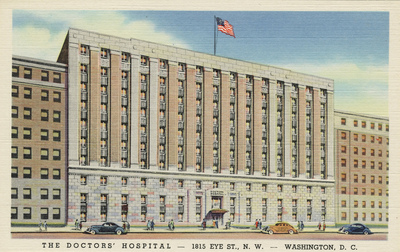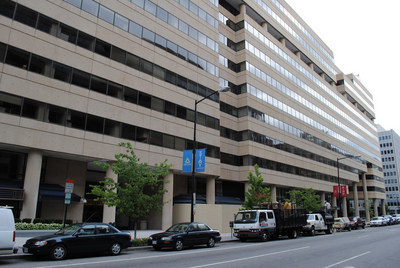Doctors’ Hospital, a “hotel for the sick”
It seems that as long as hospitals have been around, they’ve seemed dreary and depressing, or at times even unhealthful. The first DC hospital, for example, was a decidedly morbid place, opened at the Washington Asylum for indigents during a cholera epidemic in 1832.
Medical practitioners have been trying for a long time to do better than that. One major step forward occurred downtown in 1940, when a group of doctors realized their long-held vision of constructing a modern, private, un-hospital-like hospital in the 1800 block of I Street NW. The immense International Square complex, completed in 1982, fills the block now.
This particular group of doctors, led by acclaimed surgeon Dr. Charles S. White, were no strangers to building construction. Originally a group of eight, they had organized themselves in 1924 to build a medical office building on the corner of 18th and I Streets NW.
In those days physicians were increasingly relying on laboratories and other technical facilities for support, and they needed a centralized building where offices and labs could be close by.
That first eight-story building, called the Washington Medical Building, was completed by the end of 1925. It was fully occupied less than a year later, and soon more space was sorely needed. Thus a second, twin office building — called the Columbia Medical Building — was completed in 1929, at the opposite end of the block, at 19th and I.
In the middle of the block between them was a site they wouldn’t be able to get their hands on for another ten years. It had been occupied since the city’s earliest days by the Quakers, who secured it for a meetinghouse in 1808 for $465.60. By 1883 a schoolhouse was built next to the meetinghouse, and the Quakers hired a 24-year-old teacher from Baltimore, Thomas W. Sidwell, to run it.
The school, of course, flourished. Beginning in 1911, property on upper Wisconsin Avenue was bought and originally used by the school for a clubhouse. In 1937 the school consolidated at that semi-suburban location and finally sold the old I Street property to the doctors who had been coveting it for years.
The plan was to build a hospital in the center of the block, connecting it to the office buildings on both sides and thus creating a giant block-long medical complex. While the zoning commission had limited the two medical buildings to 8 stories each, they allowed the hospital building to go up to 10, which had the effect of setting it off as the centerpiece of the block.
Groundbreaking occurred in 1939, and the hospital, which cost $1.6 million to build, was ready to open its doors in March 1940. It was equipped with 250 beds, 10 operating rooms, 4 delivery rooms, and nurseries for 65 babies.
The Doctors’ Hospital building was a very restrained art moderne edifice, strikingly solid, perhaps more like a bank building than a hospital. The idea was that it shouldn’t resemble any hospital you would recognize. Walking in the front door, the lobby was supposed to look like that of a hotel.
“The first noticeable departure from the usual in hospitals is the inviting and attractive lobby, furnished and decorated completely with 18th-century authentic reproductions,” announced a commemorative book published when the hospital opened. The lobby featured a walnut wainscot and cream-colored walls. The builder, Lee Paschall, was a successful hotel man from Richmond, Virginia, who had been collaborating with the doctors since they built their first medical building. He knew what people wanted in a hotel, and he did his best to give Doctors’ Hospital that same feel.
Reviewing the new hospital in February 1940, the Washington Post quoted its administrator as saying that it was to be a ‘hotel for the sick.’ “Beds will be furnished with foam rubber mattresses and pillows. Wooden furniture, of French provincial design, will be used throughout and every room for patients will have Venetian blinds and gaily colored drapes.”
The paint schemes were muted pastels; gray-green “of a soft and restful shade” in the elevators, according to an admiring Post reviewer. Patient rooms with a southern exposure were painted with “cool, subdued shades” while those on the northern side had “warmer, creamier tints.” What more could an invalid want?
More importantly than the soothing decor, the new hospital was intended to be a model of machine-age automation and efficiency. The architects, Francisco & Jacobus of New York, were primarily an engineering firm that had built factories and power houses.
For the operating rooms, specialized treatment facilities, and other support areas at the back of the building, they designed large expanses of glass-block windows, giving that part of the building a semi-industrial feel.
In addition, much was made in the press of the hospital’s communications systems. Apparently unaware that electronic signals can be ignored as readily as mechanical bells, the Post reported:
“Special measures have been taken to eliminate the ancient complaint about nurses who fail to answer patients’ calls. Instead of a bell system, patients will have two-way communication with the central office for the floor. A secretary or floor administrator will be on duty on each floor to receive calls from patients, route directions to nurses and receive guests.”
More elaborately, the delivery rooms had foot-operated emergency call buttons, which “ring a bell at the obstetric nurse’s station, light a corridome over the delivery room door, sound a buzzer, and light a lamp at the nurse’s annunciator.” With all that commotion, somebody was sure to take notice.
The idea of industrial efficiency surely resonated deeply with the successful early-20th-century doctors who had built this hospital. And let’s be clear; they were nothing if not hard-nosed businessmen. By the time the block-long medical complex was completed, it was owned by a corporation with some 300 stockholders, most of them doctors.
All three buildings had been constructed as inexpensively as possible, were funded entirely with private funds, and were expected to turn a profit. Further, they wouldn’t take anyone who couldn’t pay. “The person who is unfortunate enough to become ill should not be expected to contribute to the support of the indigent,” Dr. White said at the hospital’s groundbreaking. “That is the responsibility of the municipality and not the duty of a small percentage of our citizens…. We expect to conduct the institution on a sound business basis…”
Doctors’ Hospital prospered during its first couple of decades. In 1950, Dr. White reported that the hospital was reliably filled to capacity, and “we always have a waiting list.” An addition was built to the rear of the hospital in 1957, bringing the total number of beds to 368, and plans were being made for a further addition as late as 1966, although those apparently were not realized.
In an article for the Post entitled “Doctors Hospital Joins The Community,” Stuart Auerbach wrote in 1968 that the formerly aloof, profit-oriented institution was beginning to loosen up a bit. A group of younger doctors had took the leadership of the hospital’s board in 1965 and made changes, including adopting a “not-for-profit” status, opening an emergency room, and accepting approximately 3 percent of patients as charity cases.
Hopes were high that the days of worrying about paying for the indigent sick were over. With the new Medicaid and Medicare programs in place, the hospital’s administrator told Auerbach that “every patient will be a private patient.”
So, with everything going along swimmingly, whatever happened to Doctors’ Hospital? It used to be right there in the heart of the downtown medical community, which is still quite extensive. But Doctors’ vanished without a trace. A combination of factors seems to have done it in, including hard-to-resist development pressures, some hints of scandal, and a dose of bad timing.
By 1973, the complex had already lost one of its three components—the original Washington Medical Building, which was torn down to accommodate Metro construction. An entrance to the Farragut West station is now on that corner.
In January of that year, the hospital owners announced grand plans to redevelop the entire property. The idea was that while the Doctors’ Hospital block would be redeveloped as commercial office space, a new hospital would be built in the next block to the west, where land was (inexplicably) much cheaper. The hospital, of course, wouldn’t move until its new home was completed.
But the plans started to fall apart almost immediately. In August, the Post published a six-part exposé on the hospital industry by Victor Cohn in which Washington-area hospitals were blasted for planning extravagant and unneeded additions and replacements.
The unneeded hospital beds would surely drive up health care costs, Cohn argued. The fallout of the series was increasing scrutiny by government regulators of hospital building plans. Doctors’ was nevertheless able to retain a “certificate of need,” which gave it approval to plan a replacement facility (some said as a result of connections between a key board member, parking-lot magnate Dominic Antonelli, and the head of the DC Department of Human Resources, Joseph P. Yeldell).
But that planning effort grew shakier all the time. Financing supposedly was difficult at the originally intended location, though health professionals favored it, and that site was sold. Other sites were proposed, as were alliances with other organizations that sought hospital space, but all ultimately fell through.
Soon Doctors’ Hospital was getting squeezed on both ends. By 1977, the first segment of the new International Square complex, on the K Street side of the block, was completed, and yet Doctors’ had nowhere to go.
One of its last gambits was to propose moving into a facility known as the Metropolitan Hotel (not to be confused with the famous hotel of the same name on Pennsylvania Avenue), which had been constructed in 1971 as an extended-care center but had been converted into a regular hotel. Much haggling with the DC government ensued over several years. The specific arguments were over financing and planning details, but the larger issue was always whether another hospital was really needed.
In September 1979, Doctors’ suddenly announced that not only had it been unable to obtain adequate financing to convert the Metropolitan Hotel into its new facility, but that it was bankrupt and would close its doors for good within weeks.
While some commentators expressed shock, other suggested that the impact of the closing on health care would be minimal, since other area hospitals indeed had extra capacity. The hospital building was torn down in 1980, and by 1982, the International Square complex—one of the few brutalist structures in DC that does not spark immediate revulsion in the eyes of most observers—filled almost all of the block. Incidentally, the Metropolitan Hotel also went bankrupt; it was renovated and is now the Renaissance Washington DC Dupont Circle Hotel.
Cross-posted at Streets Of Washington.



